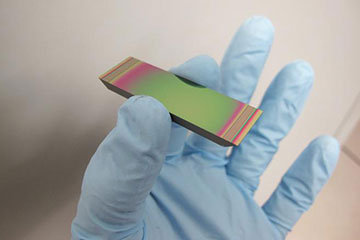
Steerable electro-evanescent optical refractor (SEEOR) chips take laser light in the mid-wavelength infrared as an input and steer the beam at the output in two dimensions without the need for mechanical devices. [Image: Jason Myers, U.S. Naval Research Laboratory]
It's a truism that mechanical devices will eventually break down, and this applies to mechanical laser-beam steering systems as well as the family automobile. In particular, for chemical sensing and lidar applications, mid-infrared beam scanning needs to be rapid and reliable—and beam-steering mechanisms such as moving mirrors and rotating prisms tend to be slow and power-hungry.
A team of U.S. scientists has devised a non-mechanical chip-based steering device for mid-infrared laser beams (J. Opt. Soc. Am. B, doi: 10.1364/JOSAB.35.000C29). The chip continuously moves beams with wavelengths of 3 to 5 μm in two dimensions and at higher scan-speed rates than gimbal-powered mirrors and similar technology.
The chip, fabricated at the U.S. Naval Research Laboratory (NRL), is a kind of solid-state device called a steerable electro-evanescent optical refractor, or SEEOR. These chips have already shown promise for steering light beams at telecommunications wavelengths and may find their way into self-driving cars of the future. The NRL scientists believe that their SEEOR is the first to operate in the mid-infrared.
Inside a SEEOR
A SEEOR looks like a small sandwich of layered thin films atop a faceted substrate—a chunk of silicon that looks like a trapezoid from the side. The sandwich contains a passive waveguide core of chalcogenide glass roughly 1.2 μm thick, a liquid-crystal layer and a cover glass with patterned electrodes. The whole chip is 48.5 mm long, 14.5 mm wide and 2.75 mm deep.
Collimated light from a 4.6-μm-wavelength quantum cascade laser enters the SEEOR at one end, and the voltage applied to the electrodes reorients the molecules of the liquid crystal, changing its refractive index in a controlled pattern.
The proof-of-concept device steered the mid-infrared beam in two dimensions: through a maximum angle of 14 degrees in the plane of the waveguide and through a 0.6-degree angle out of plane. Only about 3 percent of the input light managed to make it out of the other end of the SEEOR, but the NRL scientists say that the throughput could be greatly improved by the addition of antireflective coatings and other optimizations to reduce internal scattering.
